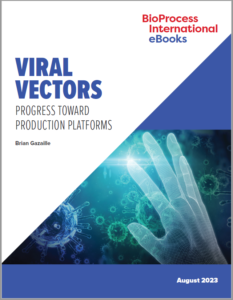eBook: Viral Vectors — Progress Toward Production PlatformseBook: Viral Vectors — Progress Toward Production Platforms
August 29, 2023
Sponsored by WuXi Biologics
 After decades of research and development (R&D) and despite more than a few clinical setbacks, viral-vector gene therapies finally are making headway into the marketplace. However, cost considerations still reverberate around the biopharmaceutical industry. Scientists recognize that nonoptimal manufacturing is implicated in the high prices for gene-therapy products. For instance, adenoassociated virus (AAV) and other such gene-delivery systems are produced at much lower scales than are monoclonal antibodies (MAbs) and other recombinant proteins — understandably so given the size and biological complexity of the vectors that need to be produced. Viable vectors also are recovered at far lower rates than their protein counterparts are. Hence comes the biopharmaceutical industry’s interest in identifying platform approaches to viral-vector production. The hope is that leveraging standardized methods and materials for large-scale vector production could help to reduce processing costs, decrease operational complexity, facilitate manufacturing consistency, and ultimately, ensure final-product quality. In lieu of broadly applicable methods and materials, gene-therapy companies and contract manufacturers are seeking to optimize currently available strategies — and the wealth of literature on viral vectors published over just the past year suggests that scientists in industry and academia are committed to increasing production scales and driving down cost of goods (CoG).
After decades of research and development (R&D) and despite more than a few clinical setbacks, viral-vector gene therapies finally are making headway into the marketplace. However, cost considerations still reverberate around the biopharmaceutical industry. Scientists recognize that nonoptimal manufacturing is implicated in the high prices for gene-therapy products. For instance, adenoassociated virus (AAV) and other such gene-delivery systems are produced at much lower scales than are monoclonal antibodies (MAbs) and other recombinant proteins — understandably so given the size and biological complexity of the vectors that need to be produced. Viable vectors also are recovered at far lower rates than their protein counterparts are. Hence comes the biopharmaceutical industry’s interest in identifying platform approaches to viral-vector production. The hope is that leveraging standardized methods and materials for large-scale vector production could help to reduce processing costs, decrease operational complexity, facilitate manufacturing consistency, and ultimately, ensure final-product quality. In lieu of broadly applicable methods and materials, gene-therapy companies and contract manufacturers are seeking to optimize currently available strategies — and the wealth of literature on viral vectors published over just the past year suggests that scientists in industry and academia are committed to increasing production scales and driving down cost of goods (CoG).
In this eBook, BPI’s managing editor explores promising studies published since 2022, providing quick impressions about where viral-vector research stands today and about what steps might be next on the path to true platform approaches. Download the eBook now to learn more about trending transfection methods, in silico analyses of host-cell metabolic pathways, and even progress toward continuous production, harvest, and clarification of viral vectors used for in vivo gene therapies.
Fill out the form below to read the full eBook now.
You May Also Like






